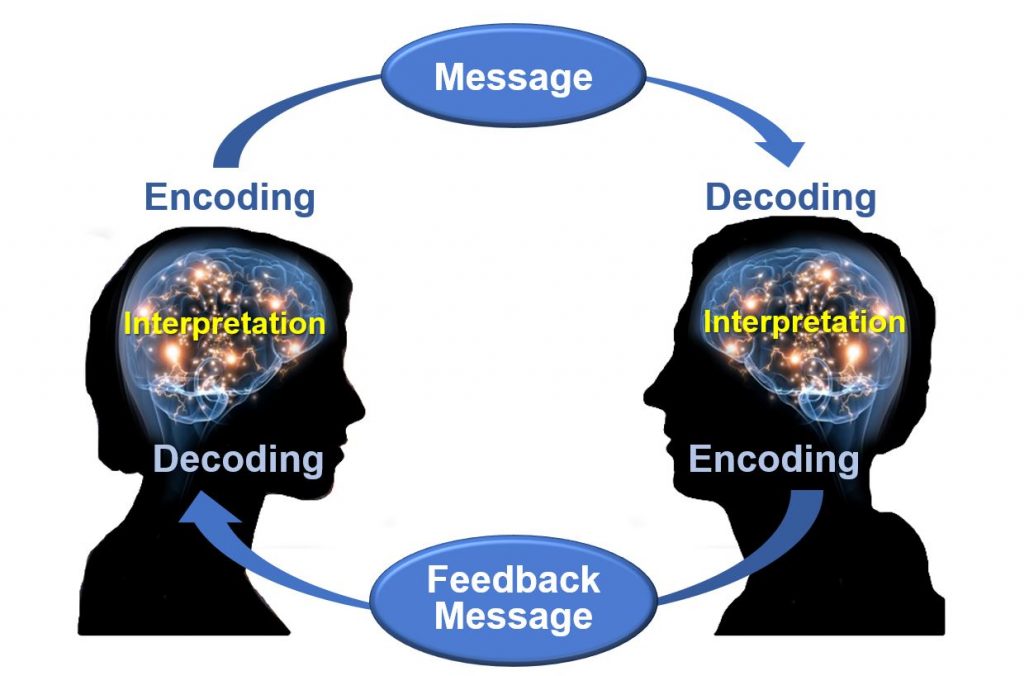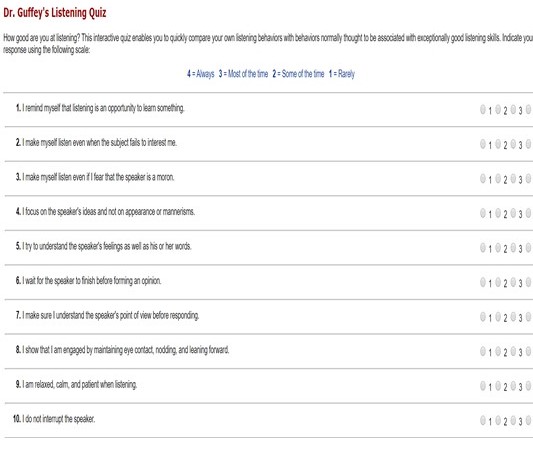1.2 The Communication Process
Learning Objectives
 After studying this unit, you will be able to
After studying this unit, you will be able to
-
-
-
- illustrate the 5 step communication process
- explain the end goal of communication
- explain barriers to clear communication
-
-
Pre-Learning Quiz
Dr. Guffey’s Listening Quiz[1]
How good are you at listening? This interactive quiz enables you to quickly compare your own listening behaviours with behaviours normally thought to be associated with exceptionally good listening skills
Introduction
Good communication skills are essential to effective business communications. At its core, the aim of communication is to transmit information from one person to another so that the sender and receiver understand the message in the same way. The responsibility for clear communication usually falls on the sender. But the receiver is also responsible to confirm a clear understanding of the message. Communication is a dynamic and cyclical process.
Breaking down the communication cycle into its parts is helpful to understand the responsibilities of both the sender and receiver of communication, as well as to identify communication barriers.
The 5 Step Communication Process

Step 1: Idea Formation – The communication process begins when the sender has an idea to be communicated. The idea will be influenced by complex factors surrounding the sender. The sender must begin by clarifying the idea and purpose. What exactly does the sender want to achieve? How is the message likely to be perceived? Knowing this information provides a higher chance of successful communication
Step 2: Message Encoding – The idea must be encoded into words, symbols, and gestures that will convey meaning. Because no two people interpret information in the exact same way, the sender must be careful to choose words, symbols and gestures that are commonly understood to reduce the chances of misunderstanding. Therefore, a sender must be aware of the receiver’s communication skills, attitudes, skills, experiences, and culture to ensure clear communication.
Step 3: Message Transmission: Choosing the medium to transmit the message is the next step in the communication process. Messages can be transmitted in a verbal, written, or visual manner (see Table 1). For clear communication to occur, the medium and message must match
Table 1.2.1: Message Transmission Mediums
| Verbal | Written | Visual |
| In-person speech | Drawings, paintings | |
| Phone conversation | Text, instant message | Photos, graphic designs |
| Voice-over-internet protocol (VoIP) | Report, article, essay | Body language (e.g., eye contact, hand gestures) |
| Radio | Letter | Graphs |
| Podcast | Memo | Font types |
| Voicemail message | Blog | Semaphore |
| Intercom | Tweet | Architecture |
Step 4: Decoding – When the message reaches the receiver, the message must be decoded into its intended meaning. Therefore, the receiver must translate the words, symbols, and gestures as the sender intended. Because no two people interpret information in the exact same way, incorrectly decoding a message can lead to misunderstanding. Successful decoding is more likely when the receiver creates a receptive environment and ignores distractions. Alert receivers strive to understand both verbal and nonverbal cues, avoid prejudging the message, and expect to learn from the communication.
Step 5: Feedback – A vital part of the communication process is feedback. Feedback occurs the sender and receiver check to ensure the message was understood as intended. Feedback is a shared responsibility between the sender and the receiver and can be verbal or non-verbal. For example, the sender can elicit feedback by asking, “Do you have any questions?” The sender can also improve the feedback process by only providing as much information as the receiver can handle. Receivers can encourage clear communication by providing clear, timely, descriptive, and non-judgmental feedback. For example, the receiver can shake his/her head up and down to confirm “yes” I have a question.
As you can see, this whole process is easier done than said because you encode incredible masses of data to transmit to others all day long in multiple channels, often at once, and are likewise bombarded with a constant multi-channel stream of information in each of the five senses that you decode without being even consciously aware of this complex process. You just do it. Even when you merely talk to someone in person, you’re communicating not just the words you’re voicing, but also through your tone of voice, volume, speed, facial expressions, eye contact, posture, hand movements, style of dress, etc. All such channels convey information besides the words themselves, which, if they were extracted into a transcript of words on a page or screen, communicate relatively little.
In professional situations, especially in important ones such as job interviews or meetings with clients where your success depends entirely on how well you communicate across the verb
and the nonverbal channels, it’s extremely important that you be in complete control of the communication process in order to present yourself as a detail-oriented pro—one that can be trusted to get the job done perfectly.
Key Takeaway

-
-
- As a cyclical exchange of messages, the goal of communication is to ensure that you’ve moved an idea in your head into someone else’s head so that they understand your idea as you understood it.
- The communication process has five steps: idea formation, encoding, channel selection, decoding and feedback.
- Anything that interferes with clear communication is called noise.
- Noise can interfere with each step of the communication process.
-
Exercises 2.1
 1. Table 1 above compiles only a partial list of channels for verbal, written, and visual channels. Extend that list as far as you can push it.
1. Table 1 above compiles only a partial list of channels for verbal, written, and visual channels. Extend that list as far as you can push it.
- Guffey, M., Loewry, D., & Griffin, E. (2019). Business communication: Process and product (6th ed.). Toronto, ON: Nelson Education. Retrieved from http://www.cengage.com/cgi-wadsworth/course_products_wp.pl?fid=M20b&product_isbn_issn=9780176531393&template=NELSON ↵


